ECO mode YAMAHA FX SHO 2012 Owners Manual
[x] Cancel search | Manufacturer: YAMAHA, Model Year: 2012, Model line: FX SHO, Model: YAMAHA FX SHO 2012Pages: 116, PDF Size: 4.49 MB
Page 3 of 116

Important manual information
EJU37154
Declaration of Conformity for Personal Watercraft (PWC)
with the requirements of Directive 94/25/EC, as amended by Directive 2003/44/EC
Name of Engine Manufacturer:YAMAHA MOTOR CO., LTD.
Name / Title:H. Yamaji / President of YAMAHA MOTOR EUROPE N.V. Address:2500 Shingai, Iwata, Shizuoka 438-8501, Japan
Name of Authorised Representative:YAMAHA MOTOR EUROPE N.V.
Address:Koolhovenlaan 101, 1119 NC Schiphole-Rijk, The Netherlands
Name of Notified Body for exhaust and noise emission assessment:Luxcontrol SA
Address:1. avenue des Terres Rouges BP 349, Esch-sur-Alzette, L-4004. Luxembourg
Name of Notified Body for exhaust and noise emission assessment:SNCH
FA1800A-L / FX Cruiser SHO, FA1800-L / FX SHO0882
0499 ID Number:
ID Number:
Address:11, route de Luxembourg BP 32, Sandweiler, L-5230. Luxembourg
US-YAMA1001A212 Conformity assessment module used:
for construction:
for exhaust emissions:
for noise emissions:
DESCRIPTION OF CRAFT
DESCRIPTION OF ENGINEA
A
Craft model Identification Number, starting from :
Model name / Commercial name :C Design Category :Other Community Directives applied
Directive 2004/108/EC relating to electromagnetic compatibility (EMC).CISPR 12
Directive 2006/42/EC relating to Machinery.Standards
EN 61000-6-2
D
Aa
AaB+C
B+CB+D
B+DB+E
B+EB+F
B+FG
G
GH
H
H
Engine Type:
PWC engineCombustion cycle:
4 stroke
Fuel Type:
Petrol
ESSENTIAL REQUIREMENTS
IDENTIFICATION OF ENGINE COVERED BY THIS DECLARATION OF CONFORMITY
Name of engine model
6CSName / ID number of Notified Body
SNCH / 0499 EC Type–examination certificate number
SNCH*94/25*2003/44*0043*00
(identification of the person empowered to sign on behalf of the engine manufacturer or his authorised representative)
Signature and title:(or an equivalent marking)Date and place of issue:1st / January / 2012, Schiphol-Rijk, The Netherlands
Essential requirementsstandardsother normative
document / methodtechnical filePlease specify in more detail
(* = mandatory standard)
I.A design and construction EN ISO 13590
I.B exhaust emission*EN ISO 8178-1
I.C noise emission*EN ISO 14509
*
*
This declaration of conformity is issued under the sole responsibility of the PWC manufacturer. I declare on behalf of the PWC
manufacturer that the craft model and engine(s) mentioned above complies (comply) with all applicable essential
requirements in the way specified and is (are) in conformity with the type(s) for which above mentioned EC type-examination
certificate(s) has (have) been issued.
ID Number:
ID Number:
UF2S70E0.book Page 1 Wednesday, December 7, 2011 3:56 PM
Page 5 of 116

Table of contents
General and important labels ........... 1
Identification numbers .................... 1
Primary Identification (PRI-ID)
number ........................................... 1
Craft Identification Number (CIN) ...... 1
Engine serial number ........................ 1
Manufactured date label .................... 2
Model information ........................... 2
Builder’s plate .................................... 2
Important labels .............................. 4
Warning labels ................................... 5
Other labels ....................................... 9
Safety information ........................... 11
Limitations on who may operate
the watercraft ............................ 11
Cruising limitations ....................... 12
Operation requirements ............... 13
Recommended equipment ........... 15
Hazard information ....................... 16
Watercraft characteristics ............. 16
Water-skiing ................................. 18
Safe boating rules ........................ 19
Enjoy your watercraft
responsibly ................................ 20
Description....................................... 21
Watercraft glossary ...................... 21
Location of main components ...... 22
Control function operation ............. 26
Watercraft control functions ......... 26
Remote control transmitter .............. 26
Yamaha Security System ................ 27
Engine stop switch .......................... 28
Engine shut-off switch ..................... 28
Start switch ...................................... 28
Throttle lever ................................... 29
Steering system ............................... 29
Adjustable tilt steering system ......... 30
Cooling water pilot outlets ............... 30
Water separator ............................... 31
Watercraft operation ....................... 32
Watercraft operation functions ..... 32
Shift system ..................................... 32
Quick Shift Trim System
(Q.S.T.S.) ..................................... 33
Watercraft operation modes ......... 35
Low RPM Mode ............................... 35
No-wake mode ................................ 36
Cruise assist .................................... 37
Instrument operation ...................... 40
Multifunction information center ... 40
Analog speedometer/tachometer .... 40
Information display .......................... 41
Multifunction display
(FX Cruiser SHO) ......................... 45
Equipment operation ...................... 49
Equipment .................................... 49
Seats ............................................... 49
Handgrip .......................................... 50
Reboarding grip ............................... 50
Reboarding step .............................. 50
Bow eye ........................................... 51
Stern eyes ....................................... 51
Cleat ................................................ 51
Pull-up cleats (FX Cruiser SHO) ...... 52
Storage compartments .................... 52
Fire extinguisher holder and
cover ............................................ 57
Operation and handling
requirements ................................... 58
Fuel requirements ........................ 58
Fuel ................................................. 58
Engine oil requirements ............... 60
Engine oil ......................................... 60
Draining the bilge water ............... 61
Draining the bilge water on land ...... 61
Draining the bilge water on water .... 62
UF2S70E0.book Page 1 Wednesday, December 7, 2011 3:56 PM
Page 7 of 116
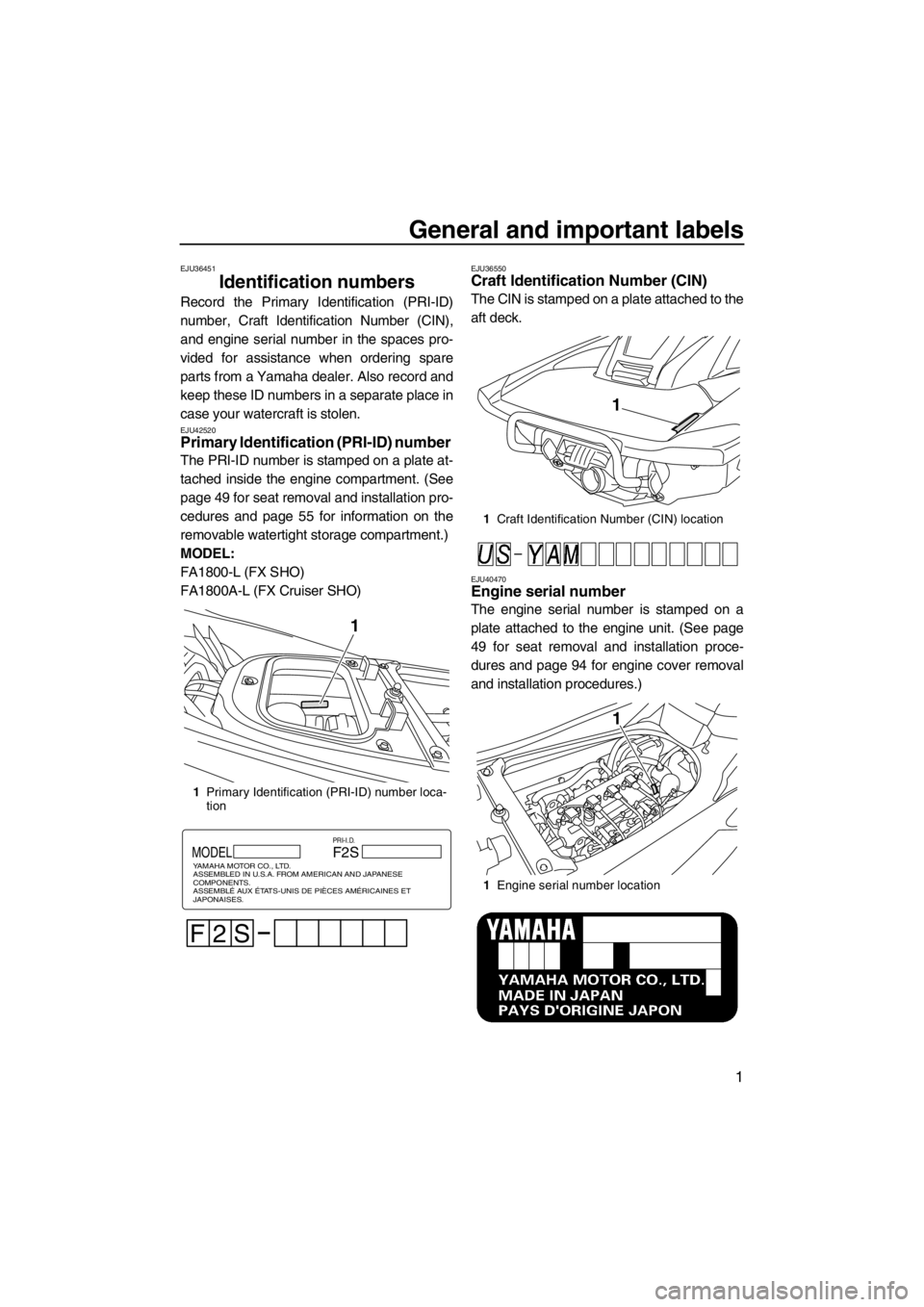
General and important labels
1
EJU36451
Identification numbers
Record the Primary Identification (PRI-ID)
number, Craft Identification Number (CIN),
and engine serial number in the spaces pro-
vided for assistance when ordering spare
parts from a Yamaha dealer. Also record and
keep these ID numbers in a separate place in
case your watercraft is stolen.
EJU42520Primary Identification (PRI-ID) number
The PRI-ID number is stamped on a plate at-
tached inside the engine compartment. (See
page 49 for seat removal and installation pro-
cedures and page 55 for information on the
removable watertight storage compartment.)
MODEL:
FA1800-L (FX SHO)
FA1800A-L (FX Cruiser SHO)
EJU36550Craft Identification Number (CIN)
The CIN is stamped on a plate attached to the
aft deck.
EJU40470Engine serial number
The engine serial number is stamped on a
plate attached to the engine unit. (See page
49 for seat removal and installation proce-
dures and page 94 for engine cover removal
and installation procedures.)
1Primary Identification (PRI-ID) number loca-
tion
1
MODELF2S
F
PRI-I.D.
YAMAHA MOTOR CO., LTD.
ASSEMBLED IN U.S.A. FROM AMERICAN AND JAPANESE
COMPONENTS.
ASSEMBLÉ AUX ÉTATS-UNIS DE PIÈCES AMÉRICAINES ET
JAPONAISES.
2S
1Craft Identification Number (CIN) location
1Engine serial number location
1
1
UF2S70E0.book Page 1 Wednesday, December 7, 2011 3:56 PM
Page 32 of 116

Control function operation
26
EJU31024
Watercraft control functions EJU42550Remote control transmitter
The Yamaha Security System and Low RPM
Mode settings can be selected by operating
the remote control transmitter. (See page 27
for Yamaha Security System setting proce-
dures and page 35 for Low RPM Mode activa-
tion procedures.)
Since the watercraft is programmed to recog-
nize the internal code from this transmitter
only, the settings can only be selected with
this transmitter.
If you accidentally lose your remote control
transmitter or if it is not operating properly,
contact a Yamaha dealer.
When operating the watercraft, always keep
the transmitter with you, such as by storing it
in the transmitter holder in the built-in water-tight storage compartment, so that it is not
lost.
NOTICE
ECJ00752
●The remote control transmitter is not
completely waterproof. Do not sub-
merge the transmitter or operate it un-
derwater. If the transmitter is
submerged, dry it with a soft, dry cloth,
and then check that it is operating prop-
erly. If the transmitter is not operating
properly, contact a Yamaha dealer.
●Keep the remote control transmitter
away from high temperatures and do not
place it in direct sunlight.
●Do not drop the remote control transmit-
ter, subject it to strong shocks, or place
any heavy items on it.
●Use a soft, dry cloth to clean the remote
control transmitter. Do not use deter-
gent, alcohol, or other chemicals.
●Do not attempt to disassemble the re-
mote control transmitter yourself. Other-
wise, the transmitter may not operate
properly. If the transmitter needs a new
battery, contact a Yamaha dealer. Refer
to local hazardous waste regulations
when disposing of transmitter batteries.
1Remote control transmitter
1Transmitter holder
1
UF2S70E0.book Page 26 Wednesday, December 7, 2011 3:56 PM
Page 42 of 116
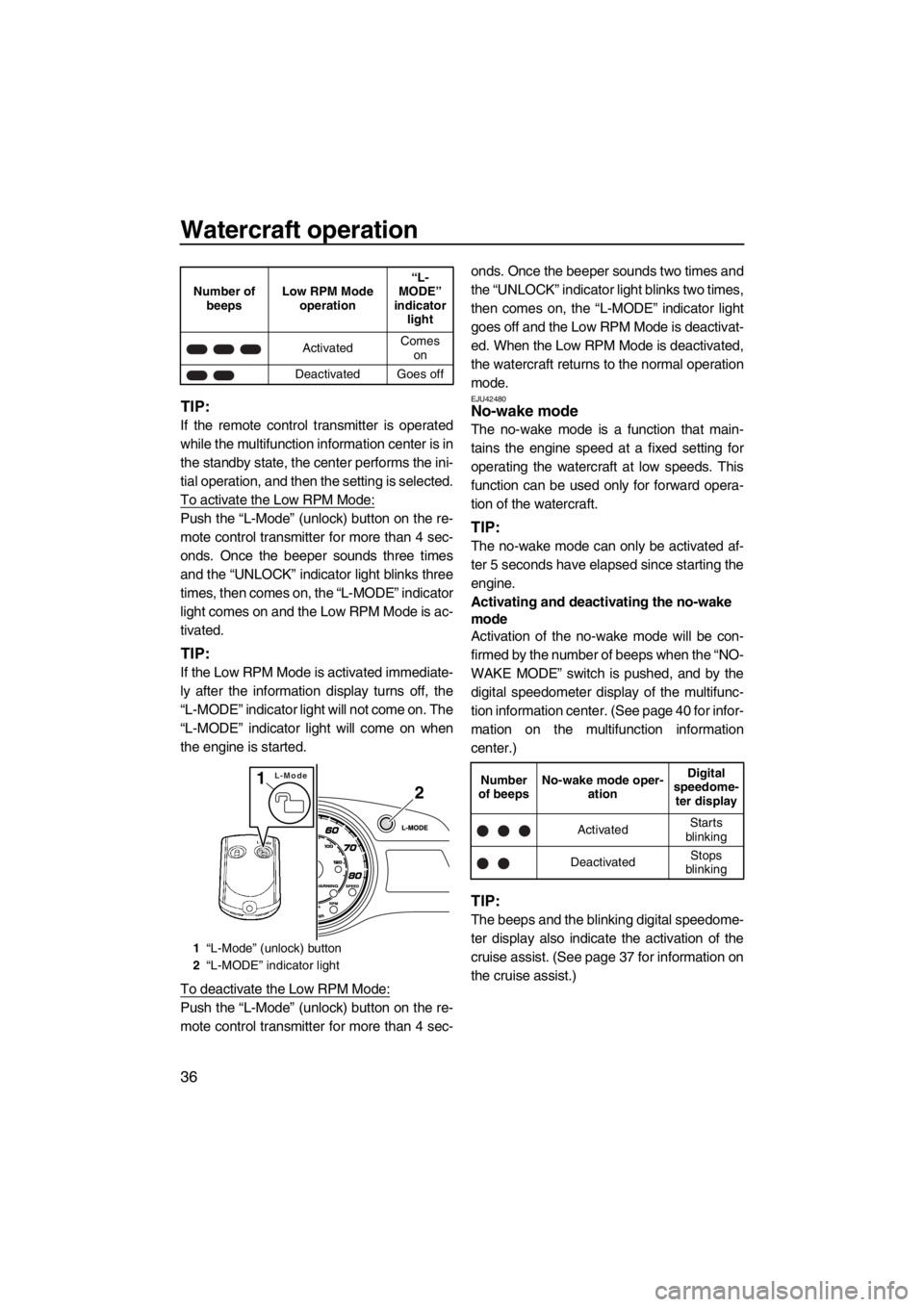
Watercraft operation
36
TIP:
If the remote control transmitter is operated
while the multifunction information center is in
the standby state, the center performs the ini-
tial operation, and then the setting is selected.
To activate the Low RPM Mode:
Push the “L-Mode” (unlock) button on the re-
mote control transmitter for more than 4 sec-
onds. Once the beeper sounds three times
and the “UNLOCK” indicator light blinks three
times, then comes on, the “L-MODE” indicator
light comes on and the Low RPM Mode is ac-
tivated.
TIP:
If the Low RPM Mode is activated immediate-
ly after the information display turns off, the
“L-MODE” indicator light will not come on. The
“L-MODE” indicator light will come on when
the engine is started.
To deactivate the Low RPM Mode:
Push the “L-Mode” (unlock) button on the re-
mote control transmitter for more than 4 sec-onds. Once the beeper sounds two times and
the “UNLOCK” indicator light blinks two times,
then comes on, the “L-MODE” indicator light
goes off and the Low RPM Mode is deactivat-
ed. When the Low RPM Mode is deactivated,
the watercraft returns to the normal operation
mode.
EJU42480No-wake mode
The no-wake mode is a function that main-
tains the engine speed at a fixed setting for
operating the watercraft at low speeds. This
function can be used only for forward opera-
tion of the watercraft.
TIP:
The no-wake mode can only be activated af-
ter 5 seconds have elapsed since starting the
engine.
Activating and deactivating the no-wake
mode
Activation of the no-wake mode will be con-
firmed by the number of beeps when the “NO-
WAKE MODE” switch is pushed, and by the
digital speedometer display of the multifunc-
tion information center. (See page 40 for infor-
mation on the multifunction information
center.)
TIP:
The beeps and the blinking digital speedome-
ter display also indicate the activation of the
cruise assist. (See page 37 for information on
the cruise assist.)
Number of
beepsLow RPM Mode
operation“L-
MODE”
indicator
light
ActivatedComes
on
Deactivated Goes off
1“L-Mode” (unlock) button
2“L-MODE” indicator light
2
L-Mode1Number
of beepsNo-wake mode oper-
ationDigital
speedome-
ter display
ActivatedStarts
blinking
DeactivatedStops
blinking
UF2S70E0.book Page 36 Wednesday, December 7, 2011 3:56 PM
Page 46 of 116

Instrument operation
40
EJU42240
Multifunction information
center
The multifunction information center displays
various watercraft information.
Multifunction information center initial op-
eration
When the multifunction information center is
activated, the analog speedometer/tachome-
ter makes one sweep, and all of the display
segments and indicator lights come on. After
2 seconds, the “WARNING” indicator light and
the warning indicators in the information dis-
play go off, and then the center starts to oper-
ate normally.
TIP:
The “UNLOCK” indicator light will go off when
the engine is started.
Multifunction information center standby
state
If the multifunction information center does
not receive any operation input within 25 sec-
onds after the engine stops, the center will
turn off and enter a standby state. When the
engine is started again, the displays return to
their state before the center turned off, and
then the center starts to operate normally.
EJU42330Analog speedometer/tachometer
The analog speedometer/tachometer has
both a speedometer function and a tachome-
ter function. By switching the meter, it can be
used as either a speedometer or a tachome-
ter.
TIP:
The analog tachometer is selected at the
Yamaha factory.
Analog tachometer
The analog tachometer shows the engine
speed.
The large outer numbers on the meter show
the engine speed × 100 rpm (r/min).
The “RPM” indicator light comes on when the
analog tachometer is selected.
1Information display
2Analog speedometer/tachometer
3Multifunction display (FX Cruiser SHO)
1“SPEED/RPM” button
2“VOLT/HOUR” button
3“START/STOP” button (FX Cruiser SHO)
4“MODE/RESET” button (FX Cruiser SHO)
312
3
4
1
2
UF2S70E0.book Page 40 Wednesday, December 7, 2011 3:56 PM
Page 48 of 116
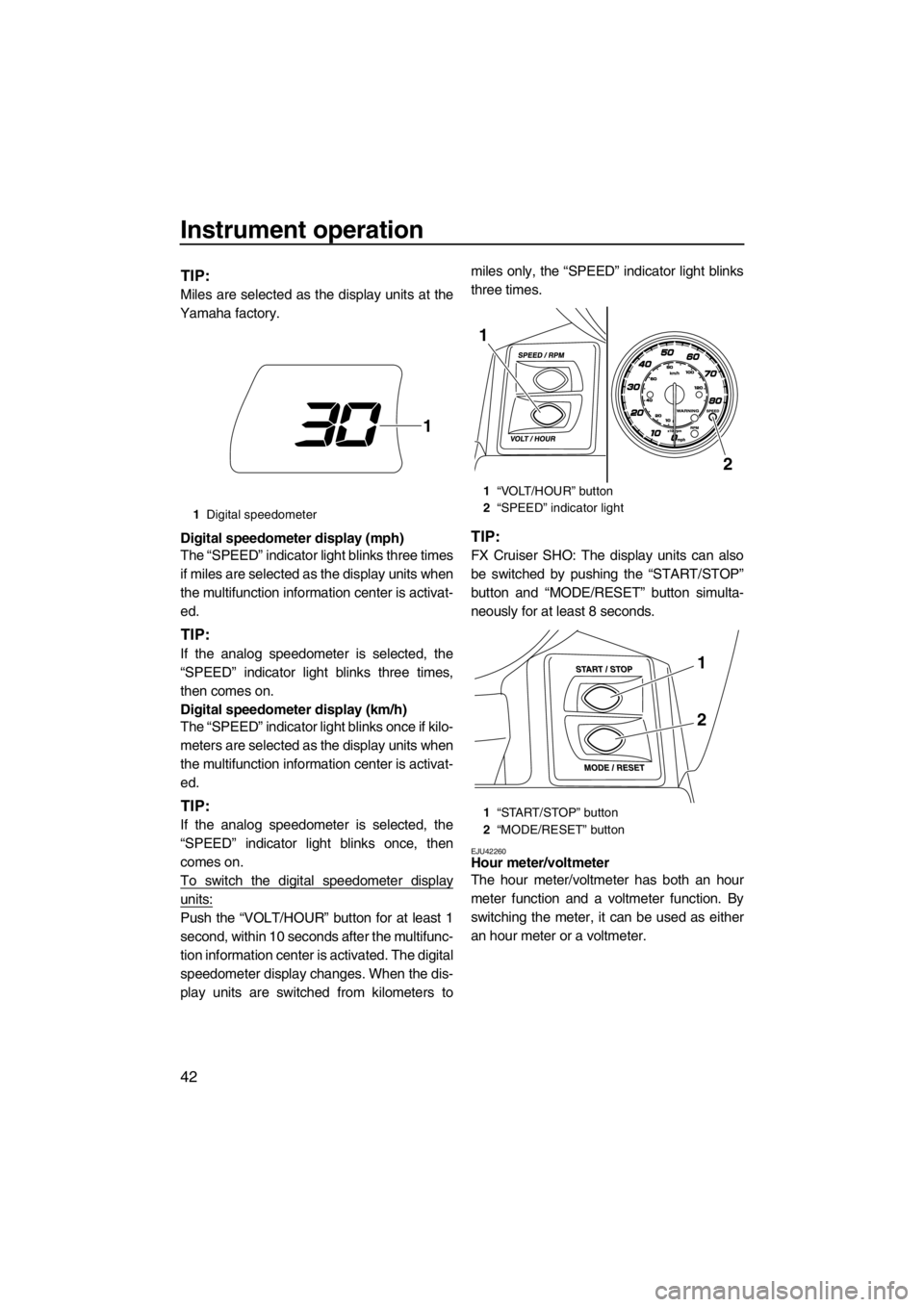
Instrument operation
42
TIP:
Miles are selected as the display units at the
Yamaha factory.
Digital speedometer display (mph)
The “SPEED” indicator light blinks three times
if miles are selected as the display units when
the multifunction information center is activat-
ed.
TIP:
If the analog speedometer is selected, the
“SPEED” indicator light blinks three times,
then comes on.
Digital speedometer display (km/h)
The “SPEED” indicator light blinks once if kilo-
meters are selected as the display units when
the multifunction information center is activat-
ed.
TIP:
If the analog speedometer is selected, the
“SPEED” indicator light blinks once, then
comes on.
To switch the digital speedometer display
units:
Push the “VOLT/HOUR” button for at least 1
second, within 10 seconds after the multifunc-
tion information center is activated. The digital
speedometer display changes. When the dis-
play units are switched from kilometers tomiles only, the “SPEED” indicator light blinks
three times.
TIP:
FX Cruiser SHO: The display units can also
be switched by pushing the “START/STOP”
button and “MODE/RESET” button simulta-
neously for at least 8 seconds.
EJU42260Hour meter/voltmeter
The hour meter/voltmeter has both an hour
meter function and a voltmeter function. By
switching the meter, it can be used as either
an hour meter or a voltmeter.
1Digital speedometer
1
1“VOLT/HOUR” button
2“SPEED” indicator light
1“START/STOP” button
2“MODE/RESET” button
2
1
1
2
UF2S70E0.book Page 42 Wednesday, December 7, 2011 3:56 PM
Page 54 of 116
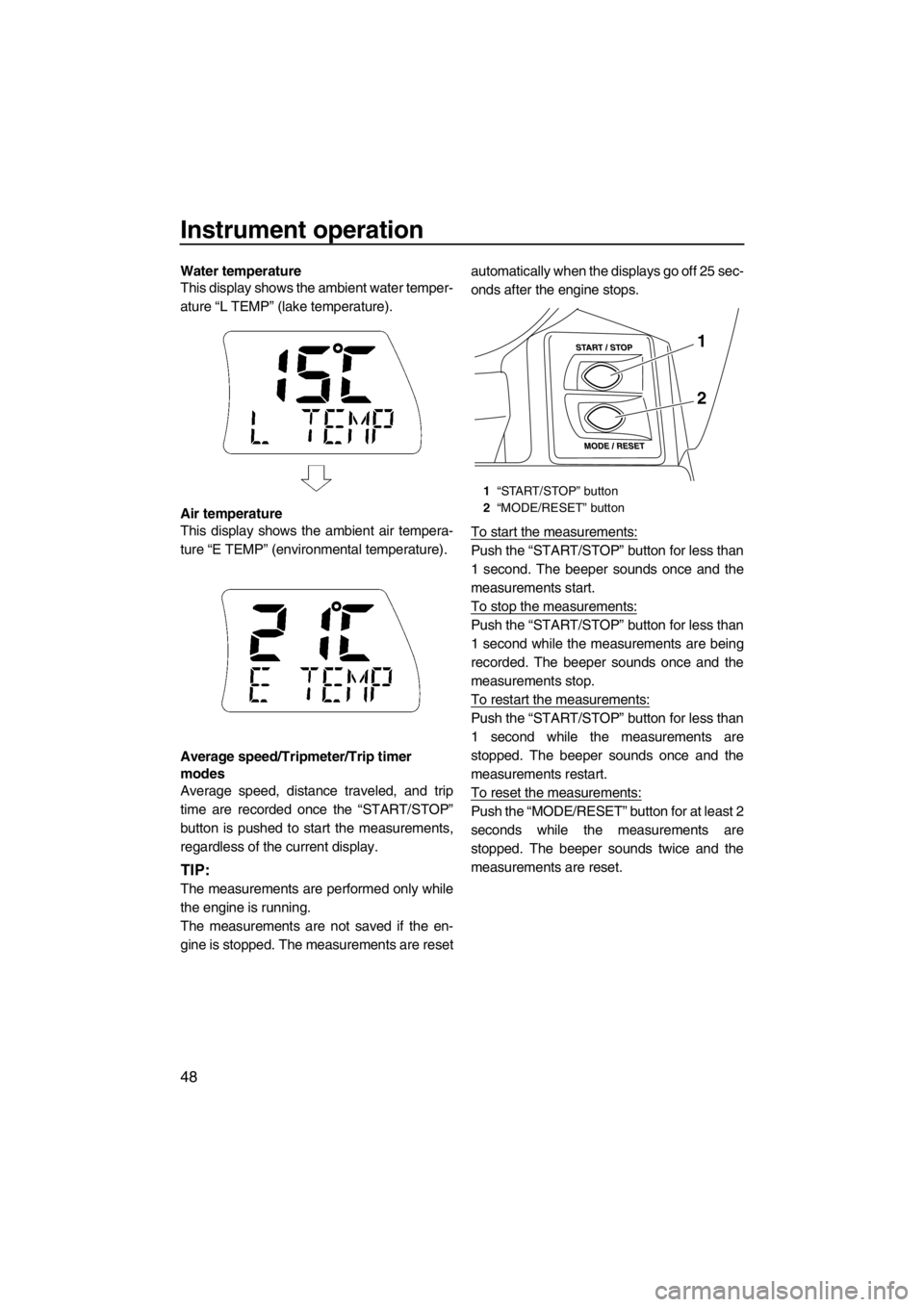
Instrument operation
48
Water temperature
This display shows the ambient water temper-
ature “L TEMP” (lake temperature).
Air temperature
This display shows the ambient air tempera-
ture “E TEMP” (environmental temperature).
Average speed/Tripmeter/Trip timer
modes
Average speed, distance traveled, and trip
time are recorded once the “START/STOP”
button is pushed to start the measurements,
regardless of the current display.
TIP:
The measurements are performed only while
the engine is running.
The measurements are not saved if the en-
gine is stopped. The measurements are resetautomatically when the displays go off 25 sec-
onds after the engine stops.
To start the measurements:
Push the “START/STOP” button for less than
1 second. The beeper sounds once and the
measurements start.
To stop the measurements:
Push the “START/STOP” button for less than
1 second while the measurements are being
recorded. The beeper sounds once and the
measurements stop.
To restart the measurements:
Push the “START/STOP” button for less than
1 second while the measurements are
stopped. The beeper sounds once and the
measurements restart.
To reset the measurements:
Push the “MODE/RESET” button for at least 2
seconds while the measurements are
stopped. The beeper sounds twice and the
measurements are reset.
1“START/STOP” button
2“MODE/RESET” button
1
2
UF2S70E0.book Page 48 Wednesday, December 7, 2011 3:56 PM
Page 78 of 116
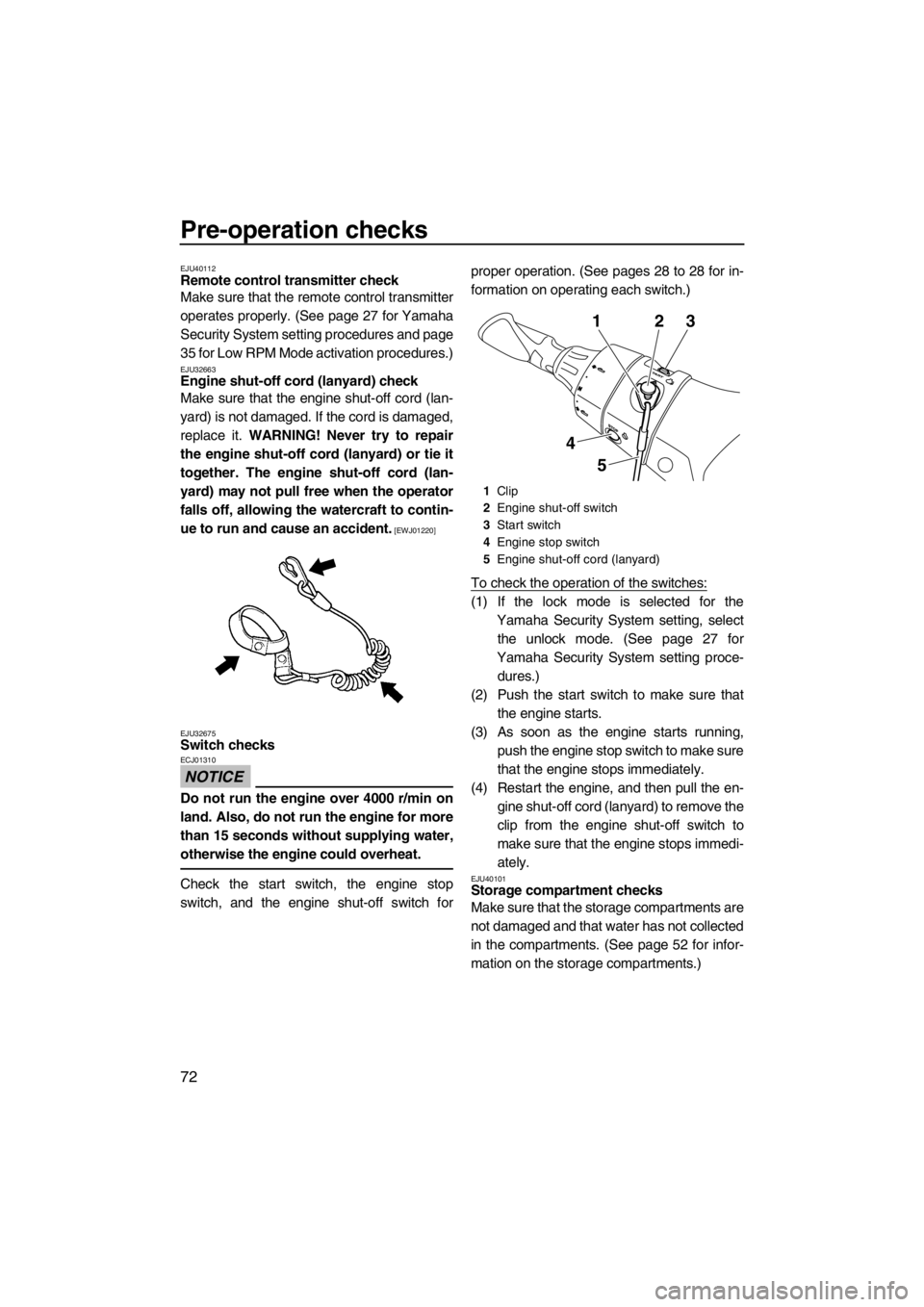
Pre-operation checks
72
EJU40112Remote control transmitter check
Make sure that the remote control transmitter
operates properly. (See page 27 for Yamaha
Security System setting procedures and page
35 for Low RPM Mode activation procedures.)
EJU32663Engine shut-off cord (lanyard) check
Make sure that the engine shut-off cord (lan-
yard) is not damaged. If the cord is damaged,
replace it. WARNING! Never try to repair
the engine shut-off cord (lanyard) or tie it
together. The engine shut-off cord (lan-
yard) may not pull free when the operator
falls off, allowing the watercraft to contin-
ue to run and cause an accident.
[EWJ01220]
EJU32675
Switch checks
NOTICE
ECJ01310
Do not run the engine over 4000 r/min on
land. Also, do not run the engine for more
than 15 seconds without supplying water,
otherwise the engine could overheat.
Check the start switch, the engine stop
switch, and the engine shut-off switch forproper operation. (See pages 28 to 28 for in-
formation on operating each switch.)
To check the operation of the switches:
(1) If the lock mode is selected for the
Yamaha Security System setting, select
the unlock mode. (See page 27 for
Yamaha Security System setting proce-
dures.)
(2) Push the start switch to make sure that
the engine starts.
(3) As soon as the engine starts running,
push the engine stop switch to make sure
that the engine stops immediately.
(4) Restart the engine, and then pull the en-
gine shut-off cord (lanyard) to remove the
clip from the engine shut-off switch to
make sure that the engine stops immedi-
ately.
EJU40101Storage compartment checks
Make sure that the storage compartments are
not damaged and that water has not collected
in the compartments. (See page 52 for infor-
mation on the storage compartments.)
1Clip
2Engine shut-off switch
3Start switch
4Engine stop switch
5Engine shut-off cord (lanyard)
132
5
4
UF2S70E0.book Page 72 Wednesday, December 7, 2011 3:56 PM
Page 87 of 116

Operation
81
movement may occur. (See page 32 for infor-
mation on operating the shift lever.)
TIP:
This model is equipped with a function which
limits the engine speed in neutral.
EJU42450Boarding the watercraft
WARNING
EWJ01111
Be sure the operator and any passengers
have practiced boarding from the water
while still close to shore before riding. A
person who has made many unsuccessful
attempts to get back on the watercraft may
become fatigued and suffer from expo-
sure, increasing the risk of injury and
drowning.
Board the watercraft in water free from weeds
and debris and at least 60 cm (2 ft) deep fromthe bottom of the watercraft. NOTICE: Never
run the engine in water that is less than 60
cm (2 ft) deep from the bottom of the wa-
tercraft, otherwise pebbles or sand could
be sucked into the jet intake, causing im-
peller damage and engine overheating.
[ECJ00472]
EJU42460
Boarding alone
(1) From the rear of the watercraft, lower the
reboarding step with one hand and hold it
in place.
1Shift lever
2Neutral position
12
60 cm (2 ft)
UF2S70E0.book Page 81 Wednesday, December 7, 2011 3:56 PM